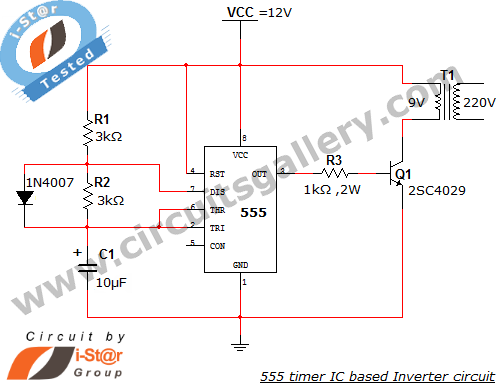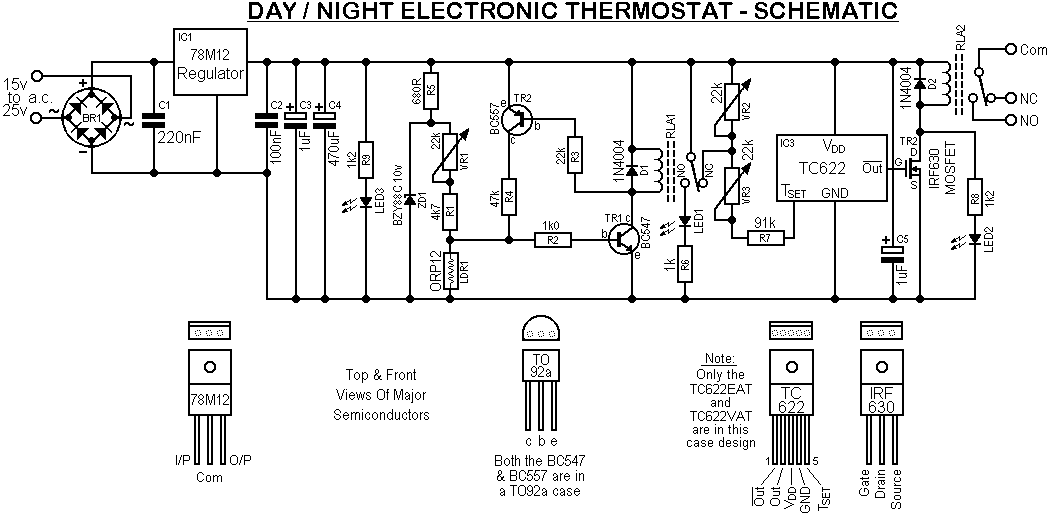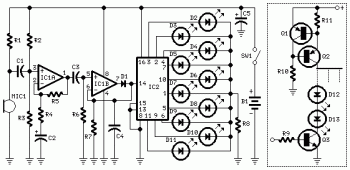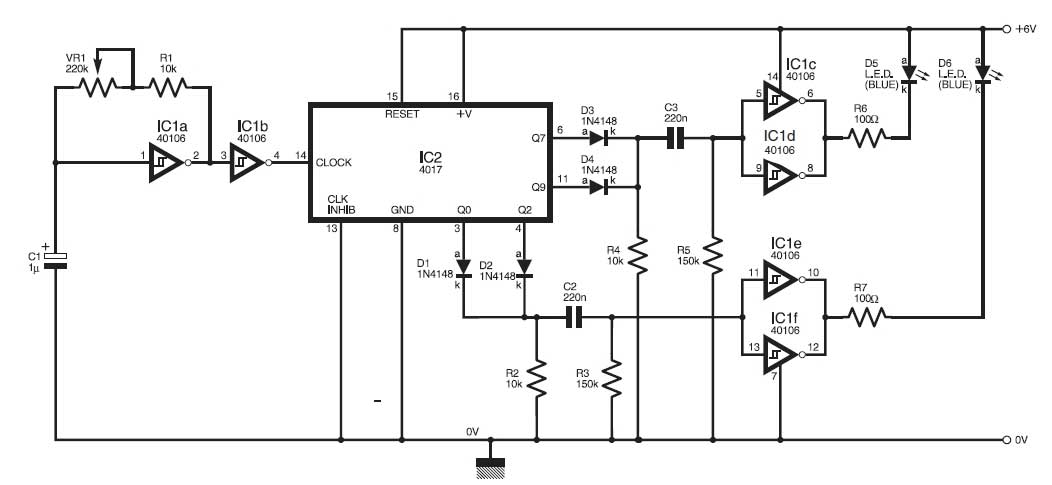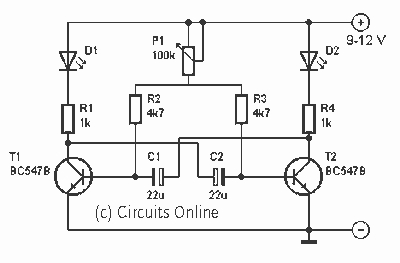
12v solar led night activated lamp

The figure illustrates a schematic for a 12V solar LED night-activated lamp circuit. This project is highly versatile and can serve various applications. For instance, it can function as an automatic solar garden light, allowing control of multiple garden lights from a single location with the convenience of a button to switch them on and off. The circuit utilizes a lead-acid battery, providing extended backup, along with an automatic 12V solar battery charger that engages in trickle charging once the battery is fully charged. Additionally, the circuit features a light-detecting mechanism that activates all LEDs at night and turns them off during the day. This circuit can also be adapted for use as an LED night light within a home by reducing the number of LEDs as needed and ensuring the solar panel is positioned to receive adequate sunlight for charging. Furthermore, it can serve as a fully automatic LED emergency light for indoor or outdoor use. The circuit can be implemented as an automatic night lamp in outdoor areas where additional lighting is necessary at night. The number of LEDs can be increased, but they must be connected in the same configuration as shown in the schematic, specifically three LEDs paired with one resistor. A 1K potentiometer is included to enhance the charging current for the 12V battery, while a 50K variable resistor is used to adjust the sensitivity of the light detection for turning the LEDs on and off. Suitable options for the 12V battery include any 12V lead-acid battery with a capacity of 4.5AH or 7AH.
The 12V solar LED night-activated lamp circuit is designed to be an efficient and user-friendly solution for both residential and outdoor lighting needs. The core components include a solar panel, a lead-acid battery, a charge controller, a light sensor, and multiple LEDs. The solar panel converts sunlight into electrical energy, charging the lead-acid battery during the day. The charge controller is crucial in preventing overcharging, automatically switching to a trickle charge mode when the battery reaches full capacity, thus extending the life of the battery.
The light sensor, typically a photoresistor (LDR), plays a pivotal role in the automatic operation of the circuit. It detects ambient light levels and controls the switching of the LEDs based on the light conditions. When the ambient light falls below a certain threshold, the circuit activates the LEDs, providing illumination during nighttime hours. This feature not only conserves energy but also enhances convenience, as users do not need to manually operate the lights.
Regarding the LED configuration, it is essential to adhere to the specified arrangement of three LEDs in series with a resistor to ensure proper current flow and prevent damage to the LEDs. The resistor value can be calculated based on the forward voltage of the LEDs and the supply voltage to optimize brightness while maintaining safety.
The inclusion of adjustable components such as the potentiometer for charging current and the variable resistor for light sensitivity allows for customization based on specific user needs and environmental conditions. This adaptability makes the circuit suitable for a range of applications, from garden lighting to emergency lighting in homes.
Overall, this 12V solar LED night-activated lamp circuit exemplifies an eco-friendly approach to lighting, utilizing renewable energy sources while providing practical solutions for various lighting requirements.Figure shows a great project / schematic of a 12V solar LED night activated lamp circuit. This is a versatile project and can be used for variety of purposes. For example you can use it as a great automatic solar garden light and this can be done easily by expending each three LEDs in a lamp in By doing this you can control all your garden lights from a single place and also switch on and off all the lights by pressing a button. The circuit is using a lead acid battery which will give a long backup and also an automatic 12V solar battery charger circuit which will automatically shift on trickle charge when the lead acid battery will completely charged. The circuit also contains a dark detecting circuit which will automatically switch on all LEDs at night and switch off in the morning.
You can also use this circuit as an LED night light in your home. For using this circuit in home you can reduce the number of LEDs as desired and make sure to fix the solar panel at the place where it will get the enough light to charge the battery. The circuit can also be used as a fully automatic LED emergency light inside home or anywhere outside.
Moreover you can also use this circuit as an automatic night lamp outside of your home where you feel the requirements of light at night. You can also increase the number of LEDs in the circuit but make sure to connect the LEDs in same manner as I connected in the circuit, like 3 LEDs with one resistor.
The 1K pot (Potentiometer) is used to increase the charging current for the 12V battery and 50K (VR) variable resistor is used to adjust the amount of light / dark on which you want to switch on and off the LEDs. For 12V battery you can use any 12V lead acid battery of 4. 5AH (amphour) or 7AH (amphour). 🔗 External reference
The 12V solar LED night-activated lamp circuit is designed to be an efficient and user-friendly solution for both residential and outdoor lighting needs. The core components include a solar panel, a lead-acid battery, a charge controller, a light sensor, and multiple LEDs. The solar panel converts sunlight into electrical energy, charging the lead-acid battery during the day. The charge controller is crucial in preventing overcharging, automatically switching to a trickle charge mode when the battery reaches full capacity, thus extending the life of the battery.
The light sensor, typically a photoresistor (LDR), plays a pivotal role in the automatic operation of the circuit. It detects ambient light levels and controls the switching of the LEDs based on the light conditions. When the ambient light falls below a certain threshold, the circuit activates the LEDs, providing illumination during nighttime hours. This feature not only conserves energy but also enhances convenience, as users do not need to manually operate the lights.
Regarding the LED configuration, it is essential to adhere to the specified arrangement of three LEDs in series with a resistor to ensure proper current flow and prevent damage to the LEDs. The resistor value can be calculated based on the forward voltage of the LEDs and the supply voltage to optimize brightness while maintaining safety.
The inclusion of adjustable components such as the potentiometer for charging current and the variable resistor for light sensitivity allows for customization based on specific user needs and environmental conditions. This adaptability makes the circuit suitable for a range of applications, from garden lighting to emergency lighting in homes.
Overall, this 12V solar LED night-activated lamp circuit exemplifies an eco-friendly approach to lighting, utilizing renewable energy sources while providing practical solutions for various lighting requirements.Figure shows a great project / schematic of a 12V solar LED night activated lamp circuit. This is a versatile project and can be used for variety of purposes. For example you can use it as a great automatic solar garden light and this can be done easily by expending each three LEDs in a lamp in By doing this you can control all your garden lights from a single place and also switch on and off all the lights by pressing a button. The circuit is using a lead acid battery which will give a long backup and also an automatic 12V solar battery charger circuit which will automatically shift on trickle charge when the lead acid battery will completely charged. The circuit also contains a dark detecting circuit which will automatically switch on all LEDs at night and switch off in the morning.
You can also use this circuit as an LED night light in your home. For using this circuit in home you can reduce the number of LEDs as desired and make sure to fix the solar panel at the place where it will get the enough light to charge the battery. The circuit can also be used as a fully automatic LED emergency light inside home or anywhere outside.
Moreover you can also use this circuit as an automatic night lamp outside of your home where you feel the requirements of light at night. You can also increase the number of LEDs in the circuit but make sure to connect the LEDs in same manner as I connected in the circuit, like 3 LEDs with one resistor.
The 1K pot (Potentiometer) is used to increase the charging current for the 12V battery and 50K (VR) variable resistor is used to adjust the amount of light / dark on which you want to switch on and off the LEDs. For 12V battery you can use any 12V lead acid battery of 4. 5AH (amphour) or 7AH (amphour). 🔗 External reference
